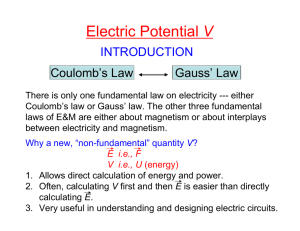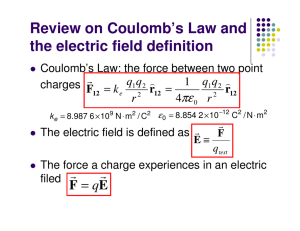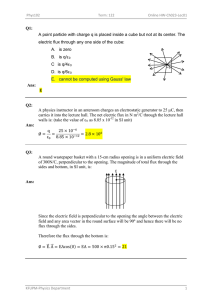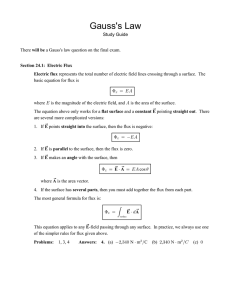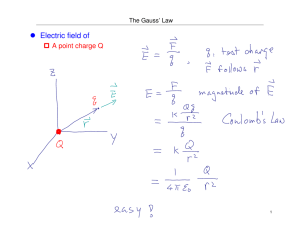Electric Fields
advertisement
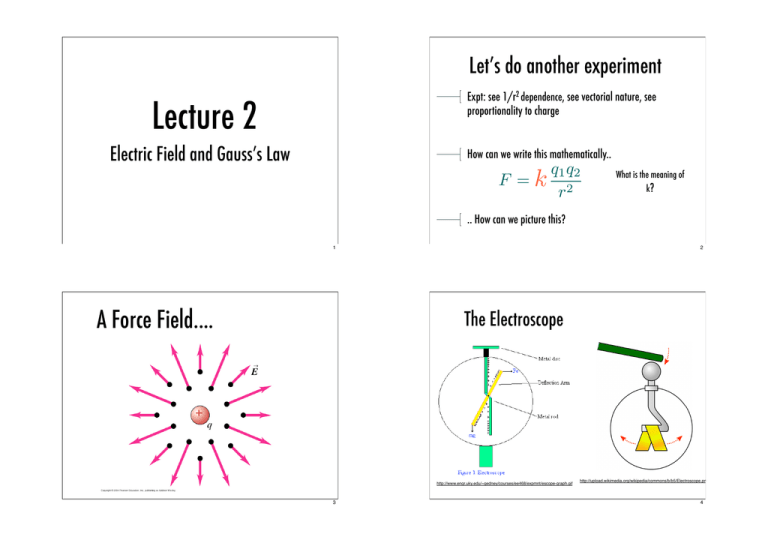
Let’s do another experiment Expt: see 1/r2 dependence, see vectorial nature, see proportionality to charge Lecture 2 Electric Field and Gauss’s Law How can we write this mathematically.. F =k q1 q2 r2 What is the meaning of k? .. How can we picture this? 1 A Force Field.... 2 The Electroscope http://www.engr.uky.edu/~gedney/courses/ee468/expmnt/escope-graph.gif 3 http://upload.wikimedia.org/wikipedia/commons/b/b5/Electroscope.png 4 What’s going on? Is the electric field real? Is it real? Does it matter? How does one charge know that the other is there? Where does the force come from? Does it go to infinity? Why not just imagine that charged particles interact with each other without the need for a mediating field? The conventional solution is to say: in this case how do they feel each other? (1) that there is an electric field surrounding every charged particle, and you can do this. If you take this approach and there is more than one charge then one calculates the individual pairs of forces and then sums them vectorially for the resultant. This can be a nightmare. You need to look at Ex. 21.3,21.4 before next lecture (2) that a charged particle within a field ‘feels’ the field and experiences a force 5 An Electric Field.... We get a real ‘small’ charge of magnitude q, and measure the force at each point in the field 6 An Electric Field.... How do we measure the field? Electric Field Units: Newtons/Coulomb Ẽ(x, y, z) = F̃ (x, y, z)/qtest This is a vector field i.e. at every point there is a direction We draw lines tangent to the force, and the density of lines naturally ends up proportional to strength of the field lines never cross Why is this? lines never terminate except on a charge i.e. at a point (x,y,z) there is a field (Ex,Ey,Ez) or could give each component separately i.e. Ex =Ex(x,y,z) & Ey = Ey(x,y,z) ... 7 8 Picturing Field Measuring fields - The Electroscope http://www.engr.uky.edu/~gedney/courses/ee468/expmnt/escope-graph.gif http://upload.wikimedia.org/wikipedia/commons/b/b5/Electroscope.png 9 An Electric Field.... 10 Electric Fields by Calculation qsource qtest 1 where k = ∼ 9 x 109 2 r 4π"0 qsource qtest r̂ where r̂ = !r/|r| F̃ = k r2 qtest qsource Electric Field Units: Newtons/Coulomb F =k Ẽ(x, y, z) = F̃ (x, y, z)/qtest This is a vector field i.e. at every point there is a direction !r i.e. at a point (x,y,z) there is a field (Ex,Ey,Ez) Ẽ = F̃ /qtest or could give each component separately i.e. Ex =Ex(x,y,z) & Ey = Ey(x,y,z) ... so Ẽ = k qsource r̂ r2 Defn: Field is force per unit test charge, think of gravity... (mass makes gravity, gravity acts on mass) 11 12 Vector Addition of Forces All positive charges Dipole Field (pls look at Ex. 21.10-21.12) Force adds vectorially, thus so does field q = 2.0 !C F = 0.29 N 0.3m q = 4.0 !C 0.4m ! ! E+ = k q+/r2 2 E- = k q-/r2 FTotal = 0.46 N Ex+ = -k |q+|/r2 cos ! Ex- = -k |q-|/r2 cos ! ExTOT = - k (|q-|+ |q+|)/r2 cos ! EyTOT = 0 0.3m E+ = -k |q+|/r2 q- - q = 2.0 !C ExTOT = - k (|q-|+ |q+ 1 |)/r2 E- = -k + |q-|/r2 13 Visualizing the field q+ 14 Lots of charges It is all very well to calculate the fields like this but isn’t there an easier way? If the charge distribution is symmetric in some way then it is possible to use an entirely different approach to get to exactly the same thing i.e. it doesn’t give you any more information than the Coulomb Law and Electric Field, but it can make things a lot easier to see. Not useful in unsymmetric situations 15 16 Flux lines Does this feel right? Expt 1: play with polystyrene ball with outgoing needles Expt 2: what about two positive charge models? What did we learn? that if I make a box of any size around the charges then the number of needles penetrating the surface is the same Positive Charge ! Outward Flux that the number of penetrating needles is proportional to the charge inside the box. if the line penetrates the box going outwards lets count as positive and if going inward then we will call negative Twice the Box ! The same Flux 17 Twice the Charge ! Twice the Flux 18 Enclosed Dipole No enclosed charge - but adjacent charge 19 20 Gauss’s Law: part 1 Field Lines and Electric Field ! =k q E r2 ΦE ∝ qenclosed but Gauss said even more... r1 but we will need to wait till next time to find this out 2r1 E1 =4 E2 A1 1 = but also A2 4 If (I) lines are continuous, & (II) Coulomb’s Law is right, & (III) lines are spherically symmetric from a point charge then Areal density of flux lines is proportional to Electric Field 21 In this lecture and the next We have covered sections 21.3-21.6 and then 22.0-22.3 in the textbook: this all part of the examinable material of the course In the next lecture we will see how to use Gauss’s law for some interesting shapes, and to realize some important things. 23 22

